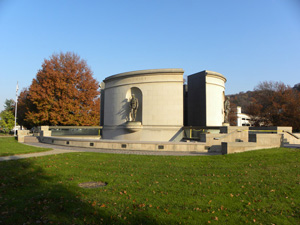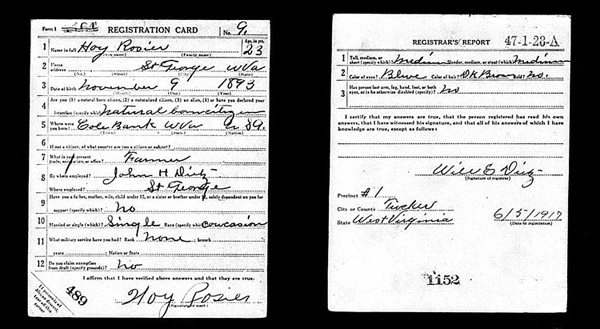

Remember...
Hoy B. Rosier
1892-1917
"The lamps are going out all over Europe: we shall not see them lit again in our life-time."
Edward Grey
 |
Remember...Hoy B. Rosier
|
Hoy B. Rosier and his twin brother Roy were born on November 9, 1893, at Colebank, a small unincorporated village that straddles the line between Preston and Barbour Counties in West Virginia. Their parents were Jacob Peter Rosier and Almyra Ellie Keiser Rosier. Roy died of unknown causes at the age of two months on January 12, 1894, and is buried near his parents in Shiloh Cemetery, Barbour County, West Virginia.
Hoy's father Jacob was a blacksmith in the Reno District of Preston County. He served as postmaster at Colebank from 1894 until 1899. Hoy's older sister Jennie Lynn and Elmer R. Hershman were married in Tucker County on July 11, 1917.
World War I, the "War to End All Wars," began in 1914 when a Serbian nationalist assassinated the heir to the Austrian-Hungarian throne. Following the sinking of American merchant ships by German submarines and an attempt by Germany to engage in a military alliance with Mexico, the United States declared war against Germany on April 6, 1917. When the call for volunteers failed to produce the needed one million troops to support the war effort, the Selective Service instituted a draft, with the first registration on June 5, 1917, for all men between the ages of 21 and 31.

WWI draft registration for Hoy B. Rosier. National Archives and Records Administration
Hoy Rosier answered the call for the World War I draft on June 5, 1917. At that time, he was a resident of St. George in Tucker County. Hoy's draft registration listed his occupation as a farmer in the employ of John H. Dietz. Hoy described himself as single and a Caucasian. He was of medium height and medium build with blue eyes and dark brown hair.
On February 20, 1918, Hoy enlisted in the United States Marine Corps at Parris Island, South Carolina, and was assigned to Company B for recruit training. On May 18, he was reassigned to Company E of the Replacement Battalion prior to departure for combat duty in France. Upon arrival in June 1918, he was transferred to the 51st Company of the 5th Regiment of the U.S. Marine Corps. During the war, the 5th Regiment participated in defensive campaigns at Toulon-Troyon, Belleau Wood, Chateau-Thierry, Marbache, and Limey. Other major battles included Aisne, the Battle of Saint Mihiel, and the Meuse-Argonne Offensive.
Private Hoy Rosier was wounded during the Meuse-Argonne Offensive, which lasted from September 26, 1918, until the Armistice on November 11, 1918. He was taken to the American Hospital at Mesves-sur-Loire, Departement de la Nievre, Bourgogne, France, where he died on October 17, 1918. Soldiers who died at the hospital were laid to rest in the Mesves Hospital Center graveyard.
In World War I, the remains of some soldiers were buried several times-first in battlefield graves, then in U.S. cemeteries in Europe, and finally in the United States. At the conclusion of the war, France had banned the removal of bodies for reburial. However, in 1920, the French capitulated to pressure from American families to repatriate the bodies of American soldiers to the United States for reburial. The remains of 46,000 war dead were returned to the U.S. at a cost of over $30 million.
Article prepared by Leon Armentrout
February 2019

West Virginia Archives and History welcomes any additional information that can be provided about these veterans, including photographs, family names, letters and other relevant personal history.